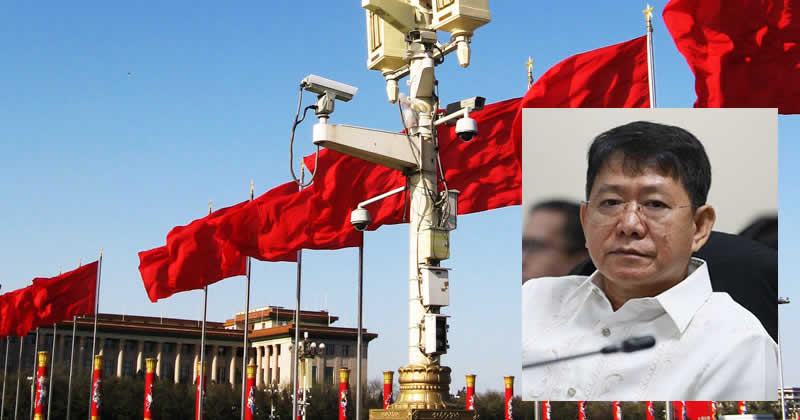|

CCTV cameras in China.
DILG Secretary Eduardo Año (insert)
Photo: Flickr, Hiddenninjaskills, Philstar
 r
is he just mouthing the talking points fed to him by Malacañang (or
Beijing). The beleaguered Philippine Secretary of the Interior, Eduardo
Año recently said that the security concerns raised by some lawmakers
with regards to the P21-billion surveillance and monitoring project of
the Department of the Interior and Local Government (DILG) and China’s
China International Telecommunications and Construction Corp. (CITCC),
was nothing to worry about. r
is he just mouthing the talking points fed to him by Malacañang (or
Beijing). The beleaguered Philippine Secretary of the Interior, Eduardo
Año recently said that the security concerns raised by some lawmakers
with regards to the P21-billion surveillance and monitoring project of
the Department of the Interior and Local Government (DILG) and China’s
China International Telecommunications and Construction Corp. (CITCC),
was nothing to worry about.
The initial phase of the
project, also known as Safe Philippines, plans to install 12,000
closed-circuit video (CCTV) cameras in both Metro Manila and Davao City.
Senator Ralph Recto voiced concern that Chinese telecom manufacturer
Huawei will provide much of the equipment for the project. The United
States, Australia, New Zealand, Great Britain, Canada, Japan, India, and
Taiwan are just a few of the countries that have banned or are planning
to ban Huawei hardware amid security concerns.
In fact, Canada recently
detained that company’s CFO Meng Wanzhou in Vancouver at the request of
the U.S. authorities for violating their laws against doing business
with Iran.
In light of all this, Año has
nonetheless decided to plunge headlong into a project that could give
the Chinese easy access to thousands of CCTV cameras—cameras that could
eventually cover the entire Philippines.
In an article in The
Philippine Star, Año countered that “the public doesn’t have to worry
about data breaches in the project as there will be no storage of
classified data or information inimical to national security in the CCTV
system.” But what Año fails to realize is that China is not interested
in the Philippine’s data, classified or otherwise. It is more interested
in the live feed from the thousands of CCTV cameras hooked-up to the
system.
The Chinese Communist
Party already has thousands of such cameras across China. They then use
sophisticated artificial intelligence (AI) algorithms that combine
biometric data to allow them to track practically anyone they want.
China has publicly stated that it intends to soon lead the world in AI.
With larger and faster supercomputers, China can easily extend its reach
across the West Philippine Sea to the Philippines, to become “big
brother China” closely watching everything Filipinos do.
Many Pinoys thought they dodged
the bullet in 2007 when the Arroyo administration’s kickback-laden
National Broadband Network (NBN) deal with another Chinese telecom giant
ZTE (a company many Western nations refuse to deal with as well) was
exposed by whistleblower Jun Lozada, Jr. The NBN-ZTE project would have
given China access to all government broadband communications—voice and
data—throughout the Philippines.
Well, that scheme did not
pan out, so China is at it again, this time with Año’s Safe Philippines
project. And the icing on the cake, as far as Chinese are concerned, is
that aside from the unprecedented access they will have to spy
on Filipinos, the Filipino people themselves will foot the
21-billion-peso bill for setting it all up. As they say in Pilipino,
niluluto tayo sa sarili nating mantika (they’re frying us in our
own oil) while laughing all the way to the bank.
Published 12/17/2018 |